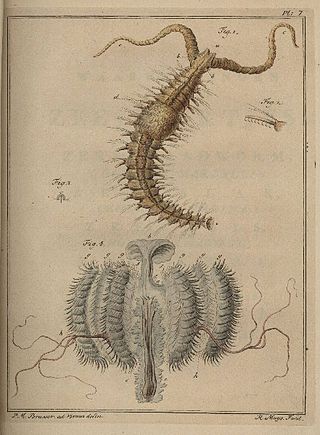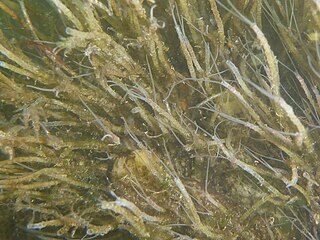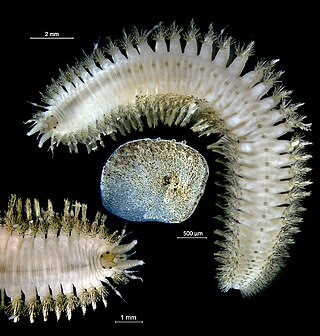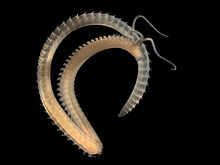
Polychaeta is a paraphyletic class of generally marine annelid worms, commonly called bristle worms or polychaetes. Each body segment has a pair of fleshy protrusions called parapodia that bear many bristles, called chaetae, which are made of chitin. More than 10,000 species are described in this class. Common representatives include the lugworm and the sandworm or clam worm Alitta.

Nereididae are a family of polychaete worms. It contains about 500 – mostly marine – species grouped into 42 genera. They may be commonly called ragworms or clam worms.

Sabellastarte spectabilis is a species of benthic marine polychaete worm in the Sabellidae family. It is commonly known as the feather duster worm, feather duster or fan worm. It is native to tropical waters of the Indo-Pacific but has spread to other parts of the world. It is popular in aquariums because of its distinctive appearance and its ability to remove organic particles and improve water quality.

Cirratulus cirratus is a species of marine polychaete worm in the family Cirratulidae. It occurs in the littoral and sub-littoral zones of the Atlantic Ocean.

Lanice conchilega, commonly known as the sand mason worm, is a species of burrowing marine polychaete worm. It builds a characteristic tube which projects from the seabed, consisting of cemented sand grains and shell fragments with a fringe at the top.

Abarenicola pacifica or the Pacific lugworm is a large species of polychaete worm found on the west coast of North America and also in Japan. The worms live out of sight in burrows under the sand and produce casts which are visible on the surface.

Lagis koreni, commonly known as the trumpet worm, is a species of marine polychaete worm found in European waters. It lives within a narrow conical tube made of grains of sand and shell fragments.

Hediste diversicolor, commonly known as a ragworm, is a polychaete worm in the family Nereididae. It lives in a burrow in the sand or mud of beaches and estuaries in intertidal zones in the north Atlantic. This species is used in research, but its classification is in dispute; in the literature, it is often classified as Nereis diversicolor. Its specific name "diversicolor" refers to the fact that its colour changes from brown to green as the breeding season approaches.

Phyllodoce mucosa is a species of polychaete worm in the family Phyllodocidae. It is found intertidally in both the Pacific and Atlantic Oceans, typically on sandy or muddy seabeds.

Phyllodoce maculata is a species of Polychaete worm in the family Phyllodocidae. It is native to the northeastern Atlantic Ocean where it inhabits shallow water areas of sand, mud and stones.

Phyllodocidae is a family of polychaete worms. Worms in this family live on the seabed and may burrow under the sediment.

Polydora ciliata is a species of annelid worm in the family Spionidae, commonly known as a bristleworm. It is a burrowing worm and is found in the northeastern Atlantic Ocean and some other parts of the world.

Phyllochaetopterus prolifica is a species of marine polychaete worms that live in a tube that it constructs. It is native to shallow waters in the eastern Pacific Ocean and forms colonies of tubes on rocks and submerged objects.

Syllis prolifera is a species of polychaete worm in the family Syllidae. It has a cosmopolitan distribution. It was first described in 1852 by the Russian/German zoologist August David Krohn who gave it the name Syllis prolifera.

Lepidonotus squamatus is a species of polychaete worm, commonly known as a "scale worm", in the family Polynoidae. This species occurs in both the Atlantic and the Pacific Oceans. It was first described by the Swedish naturalist Carl Linnaeus in 1758 as Aphrodita squamata but was later transferred to the genus Lepidonotus.
Dipolydora commensalis is a species of polychaete worm in the family Spionidae. It has a commensal relationship with a hermit crab and occurs on the lower shore of coasts on the western side of the Atlantic Ocean.
Polydora glycymerica is a species of annelid worm in the family Spionidae, native to the northwestern Pacific Ocean, where it lives commensally in association with a bivalve mollusc, usually Glycymeris yessoensis but occasionally with another species of clam. The worm intercepts food particles being drawn into the mollusc by its feeding current.

Poecilochaetus serpens is a species of marine polychaete worm in the family Poecilochaetidae. It is a benthic worm that burrows into soft sediment.

Phyllodoce lineata is a species of polychaete worm in the family Phyllodocidae. It is native to the northeastern Atlantic Ocean and the Mediterranean Sea where it occurs in the intertidal and shallow sub-tidal zones on soft sediment.

















